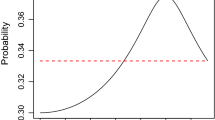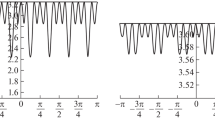Abstract
Recently, various approximate design problems for low-degree trigonometric regression models on a partial circle have been solved. In this paper we consider approximate and exact optimal design problems for first-order trigonometric regression models without intercept on a partial circle. We investigate the intricate geometry of the non-convex exact trigonometric moment set and provide characterizations of its boundary. Building on these results we obtain a solution of the exact \(D\)-optimal design problem. It is shown that the structure of the optimal designs depends on both the length of the design interval and the number of observations.

Similar content being viewed by others
References
Chang F-C, Yeh Y-R (1998) Exact \(A\)-optimal designs for quadratic regression. Statist Sinica 8:527–533
Constantine KB, Lim YB, Studden WJ (1987) Admissible and optimal exact designs for polynomial regression. J Stat Plan Inference 16:15–32
Dette H, Melas VB (2002) \(E\)-optimal designs in Fourier regression models on a partial circle. Math Methods Stat 11:259–296
Dette H, Melas VB (2003) Optimal designs for estimating individual coefficients in Fourier regression models. Ann Stat 31:1669–1692
Dette H, Melas VB, Biedermann S (2002a) A functional-algebraic determination of \(D\)-optimal designs for trigonometric regression models on a partial circle. Stat Probab Lett 58:389–397
Dette H, Melas VB, Pepelyshev A (2002b) \(D\)-optimal designs for trigonometric regression models on a partial circle. Ann Inst Stat Math 54:945–959
Dette H, Melas VB, Shpilev P (2007) Optimal designs for estimating the coefficients of the lower frequencies in trigonometric regression models. Ann Inst Stat Math 59:655–673
Dette H, Melas VB, Shpilev P (2009) Optimal designs for estimating pairs of coefficients in Fourier regression models. Stat Sinica 19:1587–1601
Dette H, Melas VB, Shpilev P (2011) Optimal designs for trigonometric regression models. J Stat Plan Inference 141:1343–1353
Fedorov VV (1972) Theory of optimal experiments. In: Studden WJ, Klimko EM (eds) Translated from the Russian. Academic Press, New York
Fitzpatrick PM (2006) Advanced calculus, 2nd edn. Thomson, New York
Gaffke N (1987) On \(D\)-optimality of exact linear regression designs with minimum support. J Stat Plan Inference 15:189–204
Hoel PG (1965) Minimax designs in two dimensional regression. Ann Math Stat 36:1097–1106
Imhof LA (1998) \(A\)-optimum exact designs for quadratic regression. J Math Anal Appl 228:157–165
Kiefer JC, Wolfowitz J (1960) The equivalence of two extremum problems. Can J Math 12:363–366
Kitsos CP, Titterington DM, Torsney B (1988) An optimal design problem in rhythmometry. Biometrics 44:657–671
Lau TS, Studden WJ (1985) Optimal designs for trigonometric and polynomial regression using canonical moments. Ann Stat 13:383–394
Marshall AW, Olkin I, Arnold BC (2011) Inequalities: theory of majorization and its applications, 2nd edn. Springer, New York
Pukelsheim F (2006) Optimal design of experiments. Society for Industrial and Applied Mathematics, Philadelphia
Wu H (1997) Optimal exact designs on a circle or a circular arc. Ann Stat 25:2027–2043
Wu H (2002) Optimal designs for first-order trigonometric regression on a partial cycle. Stat Sinica 12:917–930
Acknowledgments
We thank the referees and the editor for several comments that have helped to improve the presentation of the paper.
Author information
Authors and Affiliations
Corresponding author
Appendix
Appendix
Proof of Theorem 4.1 (a)
Part (a) of Theorem 4.1 is an immediate consequence of Theorem 2.1, since the approximate optimal designs are already exact \(n\)-point designs when \(n\) is even. \(\square \)
The following elementary lemma highlights a conclusion that can be drawn for three integers when their sum is odd and which may be false when the sum is even. It is needed several times in the proof of Theorem 4.1 (b).
Lemma 5.1
Suppose that \(j_1, j_2, j_3\) are integers and \(j_1+j_2+j_3\) is odd. If \(j_2> |j_1-j_3|-1\), then \(j_2\ge |j_1-j_3|+1\).
Proof
Suppose that \(j_2\) is even. Then \(j_1+j_3\) is odd, and so is \(j_1-j_3\). Therefore \(j_2\ne |j_1-j_3|\), and the assertion follows. The argument is similar when \(j_2\) is odd. \(\square \)
Proof of Theorem 4.1 (b)
Let \(n=2k+1\).
-
(i)
Let \(0<a<\frac{1}{4}\pi \). Let \(\xi _n\) be any \(D\)-optimal exact \(n\)-observation design, and let
$$\begin{aligned} \xi _n^{*}:= \begin{Bmatrix}-a&a \\ k/n&(k+1)/n\end{Bmatrix} , \qquad \xi _n^{**}:= \begin{Bmatrix}-a&a \\ (k+1)/n&k/n\end{Bmatrix}. \end{aligned}$$Recall from Sect. 3 that \(\mathbf{c}(\xi _n)\) is the moment point closest to the origin. Thus
$$\begin{aligned} c_1^2(\xi _n)+c_2^2(\xi _n)\!=\! \Vert \mathbf{c}(\xi _n)\Vert ^2 \le \Vert \mathbf{c}(\xi _n^{*})\Vert ^2 =\Vert \mathbf{c}(\xi _n^{**})\Vert ^2 \!=\!\cos ^2(2a)+\frac{1}{n^2}\sin ^2(2a).\nonumber \\ \end{aligned}$$(5.1)Since \(c_1(\xi _n)\ge \cos (2a)>0\), it follows that
$$\begin{aligned} |c_2(\xi _n)|\le \frac{1}{n}\sin (2a). \end{aligned}$$(5.2)Therefore, the function \(h\) defined by (3.3) and (3.2) satisfies
$$\begin{aligned} h(c_2(\xi _n))=\frac{n-1}{n}\cos (2a)+\frac{1}{n} \sqrt{1-n^2c_2^2(\xi _n)}. \end{aligned}$$Hence, by Lemma 3.1,
$$\begin{aligned} \Vert \mathbf{c}(\xi _n)\Vert ^2\ge h^2(c_2(\xi _n))+c_2^2(\xi _n) =\frac{1}{n^2}\psi (n^2c_2^2(\xi _n)), \end{aligned}$$(5.3)where
$$\begin{aligned} \psi (u):=\left\{ (n-1)\cos (2a)+\sqrt{1-u} \right\} ^2+u, \quad 0\le u<1. \end{aligned}$$But
$$\begin{aligned} \psi ^{\prime }(u)=-\frac{(n-1)\cos (2a)}{\sqrt{1-u}}<0, \quad 0\le u<1, \end{aligned}$$so that \(\psi \) is strictly decreasing. Hence, by (5.2),
$$\begin{aligned} \frac{1}{n^2}\psi (n^2c_2^2(\xi _n))\ge \frac{1}{n^2}\psi (\sin ^2(2a)) =\cos ^2(2a)+\frac{1}{n^2}\sin ^2(2a). \end{aligned}$$(5.4)Combining (5.1), (5.3) and (5.4), one obtains that none of the inequalities there can be strict. Equality in (5.3) implies that \(c_1(\xi _n)=h(c_2(\xi _n))\), and equality in (5.4) implies that \(|c_2(\xi _n)|=\frac{1}{n}\sin (2a)\). Thus, \(c_1(\xi _n)=\cos (2a)\), and it follows that all the design points of \(\xi _n\) belong to \(\{-a, a\}\). The equation \(|c_2(\xi _n)|=\frac{1}{n}\sin (2a)\) now yields that \(\xi _n=\xi _n^*\) or \(\xi _n=\xi _n^{**}\).
-
(ii)
If \(a=\frac{1}{4}\pi \), the same arguments as in (i) show that \(\xi _n^*\) and \(\xi _n^{**}\) are \(D\)-optimal. However, in this case, the function \(\psi \) is not strictly decreasing but constant, so that there may be more optimal designs. That all designs in the class given in Theorem 4.1 (b) (ii) are as good as \(\xi _n^*\) is easily verified. That there are no other \(D\)-optimal designs can be shown using Lemma 3.1 (a). We omit the details.
-
(iii)
Let \(\frac{1}{4}\pi <a<a_n^*\). It will first be shown that the moment set \(\mathcal{C}_n\) does not contain the point \(\mathbf{0}\). In view of (3.1), this implies that the moment vector of the optimal design is a boundary point of \(\mathcal{C}_n\). Let
$$\begin{aligned} \gamma :=\min \left\{ c_1(\xi _n) :\ c_2(\xi _n)=0\right\} \!, \end{aligned}$$and suppose the minimum is attained at the design \(\zeta _n\) with \(c_2(\zeta _n)=0\). We will show that \(\gamma >0\). Obviously, \(\mathbf{c}(\zeta _n)\) cannot be an interior point of \(\mathcal{C}_n\), and so, by Lemma 3.2, \(\zeta _n\) is of the form
$$\begin{aligned} \zeta _n=\begin{Bmatrix}-a&\eta&a\\ j_1/n&j_2/n&j_3/n\end{Bmatrix}. \end{aligned}$$Note that \(\zeta _n\) cannot be of the form (3.6) since \(c_2(\zeta _n)=0\). We have
$$\begin{aligned} \gamma&=c_1(\zeta _n)=\frac{j_1+j_3}{n}\cos (2a)+\frac{j_2}{n}\cos (2\eta ), \end{aligned}$$(5.5)$$\begin{aligned} 0&=c_2(\zeta _n)=\frac{-j_1+j_3}{n}\sin (2a)+\frac{j_2}{n}\sin (2\eta ). \end{aligned}$$(5.6)Reflecting \(\zeta _n\) at the origin if necessary, we may assume that \(j_1\ge j_3\). It follows from (5.6) that \(0\le (-j_1+j_3)\sin (2a)+j_2\). Also, since \(\frac{1}{4}\pi <a\le a_n^*\), \(\sin (2a)>1-\cos ^2(2a)\ge 1-1/(4k^2)\). Consequently,
$$\begin{aligned} j_2\!\ge \! (j_1-j_3)\sin (2a)\!\ge \! (j_1-j_3)\left(1-\frac{1}{4k^2} \right) \!\ge \! j_1-j_3-\frac{2k+1}{4k^2}> j_1-j_3-1. \end{aligned}$$Hence, by Lemma 5.1,
$$\begin{aligned} j_2\ge j_1-j_3+1. \end{aligned}$$(5.7)As \(j_1\ge j_3\), it now follows from (5.6) that \(\eta \ge 0\). If \(\eta \in [\frac{1}{4}\pi ,a)\), then \(\sin (2\eta )\ge \sin (2a)\), so that, by (5.6), \(0\ge (-j_1+j_3+j_2)\sin (2a)\), contradicting (5.7). Thus \(\eta \in [0,\frac{1}{4}\pi )\), and so \(\cos (2\eta )>0\). Therefore, by (5.5) and (5.6),
$$\begin{aligned} n\gamma \!&= \! (j_1+j_3)\cos (2a)+j_2\sqrt{1-\sin ^2(2\eta )}\\ \quad&= (j_1+j_3)\cos (2a)+\sqrt{j_2^2-(j_1-j_3)^2\sin ^2(2a)}. \end{aligned}$$This expression is positive if and only if
$$\begin{aligned} j_2^2>(j_1-j_3)^2+4j_1j_3\cos ^2(2a). \end{aligned}$$But this inequality follows from (5.7) and the fact that \(4j_1j_3\cos ^2(2a)< 4k^2\cos ^2(2a_n^*)=1\). Hence \(\gamma >0\). It is thus established that \(\mathbf{0}\not \in \mathcal{C}_n\). Now let \(\xi _n\) be \(D\)-optimal and
$$\begin{aligned} \xi _n^*= \begin{Bmatrix}-a&0&a\\ k/n&1/n&k/n\end{Bmatrix}. \end{aligned}$$According to (3.1), \(\mathbf{c}(\xi _n)\) has minimum norm in \(\mathcal{C}_n\). In particular,
$$\begin{aligned} \Vert \mathbf{c}(\xi _n)\Vert \le \Vert \mathbf{c}(\xi _n^*)\Vert = \frac{1+2k\cos (2a)}{n}<\frac{1}{n} \end{aligned}$$(5.8)and \(\mathbf{c}(\xi _n)\) must be a boundary point of \(\mathcal{C}_n\). Using (3.7) and (5.8), one may show that \(\xi _n\) cannot have the form (3.6). It therefore follows by Lemma 3.2 that \(\xi _n\) is of the form (3.5)
$$\begin{aligned} \xi _n=\begin{Bmatrix}-a&\theta&a\\ k_1/n&k_2/n&k_3/n\end{Bmatrix}. \end{aligned}$$Observe that this implies that \(\mathbf{c}(\xi _n)\) lies on the circle with center
$$\begin{aligned} \overline{\mathbf{c}}=\frac{1}{n} \begin{pmatrix}(k_1+k_3)\cos (2a)\\ (-k_1+k_3)\sin (2a)\end{pmatrix} \end{aligned}$$and radius \(k_2/n\). If \(k_2\le |k_1-k_3|-1\), then
$$\begin{aligned} \Vert \mathbf{c}(\xi _n)\Vert&\ge \Vert \overline{\mathbf{c}}\Vert -\frac{k_2}{n} = \frac{1}{n}\sqrt{(k_1-k_3)^2+4k_1k_3\cos ^2(2a)}-\frac{k_2}{n}\\&\ge \frac{1}{n}|k_1-k_3| -\frac{1}{n}(|k_1-k_3|-1) = \frac{1}{n}. \end{aligned}$$This contradicts (5.8). Thus \(k_2>|k_1-k_3|-1\), and so, by Lemma 5.1, \(k_2\ge |k_1-k_3|+1\). In particular, since \(k_2\ge 1\), \(k_1k_3=k_1(2k+1-k_1-k_2)\le k^2\), and \(k_1k_3=k^2\) if and only if \(k_1=k_3=k\) and \(k_2=1\). It follows that
$$\begin{aligned} \Vert \mathbf{c}(\xi _n)\Vert&\ge \frac{k_2}{n}-\Vert \overline{\mathbf{c}}\Vert = \frac{k_2}{n}-\frac{1}{n}\sqrt{(k_1-k_3)^2+4k_1k_3\cos ^2(2a)}\end{aligned}$$(5.9)$$\begin{aligned}&\ge \frac{|k_1-k_3|+1}{n}-\frac{1}{n}\sqrt{(k_1-k_3)^2+(2k\cos (2a))^2} =:A. \end{aligned}$$(5.10)If \(\beta <0\), then \(\sqrt{\alpha ^2+\beta ^2}\le |\alpha |-\beta \) with equality if and only if \(\alpha =0\). Using this inequality and (5.8), one obtains that
$$\begin{aligned} A\ge \frac{|k_1-k_3|+1}{n} -\frac{1}{n} \left\{ |k_1-k_3|-2k\cos (2a)\right\} =\frac{1+2k\cos (2a)}{n} \ge \Vert \mathbf{c}(\xi _n)\Vert .\nonumber \\ \end{aligned}$$(5.11)Consequently, all inequalities in (5.9), (5.10) and (5.11) must be equalities, so that \(k_1=k_3=k\) and \(k_2=1\). Moreover, in view of (5.9), \(\Vert \overline{\mathbf{c}}\Vert + \Vert \mathbf{c}(\xi _n)\Vert =k_2/n=\Vert \overline{\mathbf{c}}-\mathbf{c}(\xi _n)\Vert \), which implies that \(\overline{\mathbf{c}}\) and \(\mathbf{c}(\xi _n)\) are proportional. Thus \(\theta =0\).
-
(iv)
If \(a_n^*\le a \le \pi \) and
$$\begin{aligned} \xi _n = \begin{Bmatrix}-a_n^*+\theta&\theta&a_n^*+\theta \\ k/n&1/n&k/n\end{Bmatrix} \end{aligned}$$for some \(\theta \in [-a+a_n^*, a-a_n^*]\), then \(\Vert \mathbf{c}(\xi _n)\Vert =0\), so that, by (3.1), \(\xi _n\) is \(D\)-optimal. \(\square \)
Rights and permissions
About this article
Cite this article
Chang, FC., Imhof, L. & Sun, YY. Exact \(D\)-optimal designs for first-order trigonometric regression models on a partial circle. Metrika 76, 857–872 (2013). https://doi.org/10.1007/s00184-012-0420-x
Received:
Published:
Issue Date:
DOI: https://doi.org/10.1007/s00184-012-0420-x




